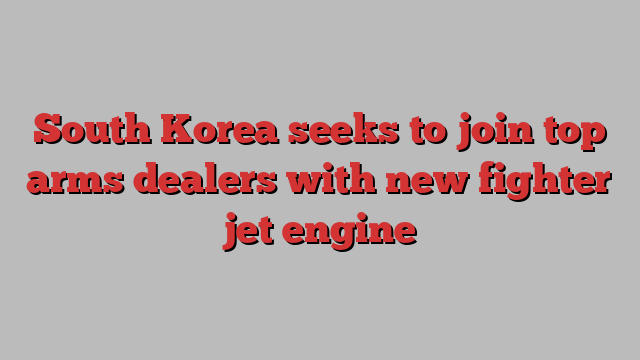
Stay informed with free updates
Simply sign up to the Aerospace & Defence myFT Digest — delivered directly to your inbox.
South Korea’s largest defence company is developing a fighter jet engine as the country works to move up the arms exporter value chain and boost its security self-sufficiency.
The chief of aero systems at Hanwha Aerospace said the company wanted to develop the engine by as early as 2036. It is working in partnership with the South Korean government, one of the world’s highest spenders on arms development.
“We should develop our own aircraft engines before it is too late for our long-term national security, as well as for economic benefits,” said Kwangmin Lee in an interview with the Financial Times at the company’s headquarters in Seoul.
“It will take at least 10 years and more than Won5tn [$3.7bn]. We face high entry barriers, but we have experience producing engines, albeit under licensed deals, and have developed small engines of our own and have a strong supply chain,” he said.
South Korea has become one of the world’s top 10 defence exporters, with the war in Ukraine driving demand for conventional arms such as tanks, howitzers and lower-end fighter jets.
Hanwha makes its own engines for ships, missiles and helicopters but has yet to produce an advanced fighter jet engine. It is a major parts supplier for General Electric, Pratt & Whitney and Rolls-Royce, which together dominate the global aircraft engine market.
The company is targeting Won25tn in total sales of its own engines by 2050. The engines are expected to be used in upgraded versions of the country’s first homegrown fighter jet, the KF-21, which Korea Aerospace Industries plans to mass produce in the second half of 2026.
Hanwha is currently assembling the F414 turbofan engines used in the KF-21 under licence with GE. “We will develop engines that are similar to GE’s F414 class but have much better thrust and fuel consumption,” said Lee.
He admitted that it was a difficult undertaking. “There is a lot of scepticism over whether Ford can catch up with Ferrari, but you can’t achieve anything without trying,” said Lee, referring to the US carmaker’s battle to develop a race car rivalling the Italian group.
Only six countries have indigenous engines to power the most modern fighter jets: the US, the UK, France, Russia, Ukraine and China.
Japan’s industrial group IHI presented an engine prototype when the country wanted to independently develop its own fighter jet. But it is now working alongside Rolls-Royce under the trilateral Global Combat Air Programme to build a supersonic jet with the UK and Italy.
After years of delays, the Indian government is collaborating with GE to develop its Kaveri engines. Turkey has also held talks with Rolls-Royce to co-develop engines for its fighter jet.
France’s Safran, Russia’s UEC-Aviadvigatel, Ukaine’s Ivchenko-Progress and China’s AECC also produce aircraft engines.
Hanwha is building a $30mn aircraft engine factory in South Korea and plans to triple the number of its domestic engineers to 600. It plans to set up overseas research centres in the US and Europe and is considering collaborating with other companies for its own engine project.
The company expects the South Korean air force to buy the upgraded KF-21s with its own engines and hopes to eventually sell them to countries in the Middle East, south-east Asia and eastern Europe.
“We will target those who can’t buy fighter jets from the US for geopolitical reasons or those who can’t afford to buy expensive US jets,” said Lee.
Douglas Barrie, senior fellow at the International Institute for Strategic Studies, said Hanwha had the “technical industrial base to at least give it a really good go, but you should still not underestimate the challenges involved in this”.
Kim Ho-sung, professor of advanced defence engineering at Changwon National University, warned that the technology was difficult to develop.
“Developing a jet engine is the most complex technological feat, as the materials need to withstand combustion heat beyond 2,000 degrees Celsius,” said Kim. “Even China had trouble overcoming the technological challenges until recently.”
South Korea produces high-quality arms for less money, making them attractive to buyers in emerging markets. But Kim cautioned against Hanwha using the same strategy for the aircraft engine market, predicting that it would be difficult for the company to achieve economies of scale.
“Countries can easily buy the [US-made] F-15 with proven safety and superior performance. Why would they bother to buy the KF-21 with Korean-made engines at similar prices?” said Kim. “It will be difficult to secure cost competitiveness without economies of scale. Global collaboration could be a better option for Korea.”
Additional reporting by Sylvia Pfeifer in London